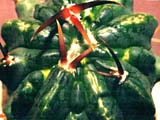FROM OUR COLLECTIONS
By Nikolay Shemorakov (Kaluga, Russia)
1. RARE MUTATION
Collectors of the colored forms of cacti very often come across different phenotypic (exterior) display of plastid mutations. Some types of mutations are more common then others. And some of them are very rare.
Some types of plastid mutations can be noticed before the first areoles even started to appear; others are visible when ten to twenty areoles are formed, and some of plants reveal their mutation closer to first blooming. This happened in my collection not once. More often they were green-yellow mutants (type: virido-xantha). This color combination happens very often. Less frequent there were variegated combination of pink and brown, as it happened with the hybrid of Gymnocalycium mihanovichii 'Mille Petrozza' (Photo 1).
Very unexpected color combination was found on the four year old seedling of Gymnocalycium mihanovichii var. pirarettaense. In May a whitish spot was found on one of its ribs, in the end of the month another spot started to form on the same rib, closer to the apex (Photo 2). Bright sun of May made it slightly yellowish.
In August the spots grew bigger with the seedling growth. The bigger spot became white and the smaller one formed a green spot in the center. Traces of lighter spots appeared on other ribs.
It's not a secret that white mutants are scarce and rarely survive. Green-white variegated cacti are quite rare but can be grown on their own roots. And I've never seen or read about 'virido-alba' (green-yellow) type of mutation among varieties or hybrids of Gymnocalycium mihanovichii. This type of mutation is not peculiar to the genus in general.
Unfortunately, Gymnocalycium mihanovichii var. pirarettaense produce shoots not quite easily even when mature, so fast propagation of the mutation bearer is not possible.
2. INTRODUCING – 'Mike Tyson'

Photo 3.

Photo 4.
| |
Members of the Echinofossulocactus genus seldom generate any mutations. However one of my six year old seedlings of E. coptonogonus as if decided that its species is not decorated enough. Therefore, it started to beautify itself despite the nature. In the end of spring light spots started to appear on its new growth. Some of them showed green spots inside (Photo 3), some reddened on the bright sun. This year the seedling grew faster then before and to the end of summer transformed into a tough plant with light spots depressed on tops of some ribs. It didn't stop there and decided to complicate the ornament. On all ribs of the new growth you can see the darker spots arranged into a bizarre pattern (Photo 4). This pattern probably appeared because of lack of a wax layer on some areas of the stem. Thus the seedling showed us that it can be decorated not only by plastid mutation, a crest or monstrosity but also by a bizarre skin script resembling a tattoo.
It is possible that the spot skin is not containing stomata, but I don't dare to cut such a unique cactus to check the assumption. I called the cultivar 'Mike Tyson' in honor of my favorite boxer.
Propagation of this unique plant shouldn't be problematic since it grafted on Cereus peruvianus and the mother plant already formed three side shoots. Hopefully I will graft them too.
Photographs are taken by the author.





